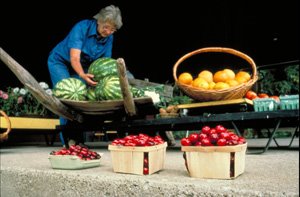From the eye of the potato, #3
Agriculture News
 A collaboration by MSU Extension, the Michigan Coalition of Black Farmers and Branches of the Vine Food Buyers Cooperative is bringing fresh, locally grown fruits and vegetables to low-income Detroit neighborhoods.
A collaboration by MSU Extension, the Michigan Coalition of Black Farmers and Branches of the Vine Food Buyers Cooperative is bringing fresh, locally grown fruits and vegetables to low-income Detroit neighborhoods. Members of a Detroit neighborhood are getting a chance to learn about production agriculture and livestock raising, thanks to a partnership effort between Michigan State University (MSU) Extension, the Michigan Coalition of Black Farmers and Branches of the Vine Food Buyers Cooperative.
According to Mike Score, MSU Extension educator in Washtenaw County, the food cooperative is designed to provide people from low-income neighborhoods with fresh, locally grown produce. Score and Peacemakers International Ministries, a church working with the food cooperative, accept food orders from neighborhood residents. Food orders are filled by wholesalers at Detroit’s Eastern Market and local farmers.
Score says the Michigan Coalition of Black Farmers recognized that this neighborhood needed a source of fresh fruits and vegetables and worked with Score to help identify a solution to the problem. “The Michigan Coalition of Black Farmers identified that this neighborhood needed a system for supplying its citizens with access to fresh produce,” Score says. “Though we originally thought about organizing a farmers’ market in the area, it was more efficient and economical to develop this process, which allows citizens to place food orders with us.”
Though the food cooperative was not able to accept food stamps when it started, more than $400 of food was sold during the first month of operation. The club recently activated an electronic food stamp reader, which gives more people a chance to participate in the program.
“It’s not likely that a grocery store will be built in this neighborhood,” Score says. “That’s one of the reasons we’re here helping -- these people need access to wholesome, fresh food.”
The need to reduce our dependence on petroleum and develop alternate sources of energy has put renewable, plant-based biofuels in the headlines lately. Ethanol production from corn is one option that has grabbed the most attention, though many folks who have studied this process from all sides are generally not proponents. Big Ag companies like ADM and Cargill are pushing it pretty hard, but you'll be hard pressed to find neutral parties speaking highly of this process that costs nearly as much energy to produce as it generates.
Switchgrass [Panicum virgatum], on the other hand has much more promise. Switchgrass can be used to produce ethanol just like corn, but, since it's a native perennial, it takes much much less energy to produce biomass. Unlike corn, annual tillage, cultivating and seeding are not necessary for switchgrass.
 Here's a story about another example of valuable agricultural research - at least in my view. A study conducted by a 'watchdog' organization called the Environmental Working Group found that a relatively small percentage of rural counties - many of them in Illinois - are contributing most of the fertilizer pollution that is creating a seasonal "dead zone" in the Gulf of Mexico, where a summertime algae bloom suppresses most other aquatic life. Specifically, they found that 5% of the Mississippi River Basin contributes 40% of the runoff nitrate that shows up in the Gulf. And counties representing 15 percent of the Mississippi River watershed account for 80 percent of the total fertilizer pollution that washes into the river, according to EWG's report. And, many of these farmers are using these environmentally unfriendly farming systems because government subsidy payments make it more lucrative than less harmful systems.
Here's a story about another example of valuable agricultural research - at least in my view. A study conducted by a 'watchdog' organization called the Environmental Working Group found that a relatively small percentage of rural counties - many of them in Illinois - are contributing most of the fertilizer pollution that is creating a seasonal "dead zone" in the Gulf of Mexico, where a summertime algae bloom suppresses most other aquatic life. Specifically, they found that 5% of the Mississippi River Basin contributes 40% of the runoff nitrate that shows up in the Gulf. And counties representing 15 percent of the Mississippi River watershed account for 80 percent of the total fertilizer pollution that washes into the river, according to EWG's report. And, many of these farmers are using these environmentally unfriendly farming systems because government subsidy payments make it more lucrative than less harmful systems.Ken Cook, president of the Environmental Working Group, said the analysis makes a strong argument that more federal money should be shifted from farm subsidies to conservation programs in the areas that contribute the most fertilizer runoff into the river. He noted that thousands of farmers have been denied funding for conservation programs because there simply wasn't enough money to pay them.
 I agree that we need to shift away from the current subsidies system and instead encourage conservation programs. I wish there was more funding for this kind of essential research. Read the full story at the Chicago Trib.
I agree that we need to shift away from the current subsidies system and instead encourage conservation programs. I wish there was more funding for this kind of essential research. Read the full story at the Chicago Trib.- Lastly, grow your very own grass armchair in your backyard. Consider its location and orientation seriously though, its a bugger to move. And to mow. [via Popular Science]
I'd heard of this program a year or so ago, before they'd figured out how to add the food stamp system. At that time, there were more disappointments than successes to hear about. The motivations for the project are found in the layout and logistics of low-income neighborhoods and food delivery systems - no grocery stores, no cars, often poor access to transportation to outlying groceries many miles away. Folks in these neighborhoods often shop for food at local gas stations and convenience stores within walking distance. Therefore their diets include little or no fresh fruits and vegetables.
Technorati tag(s): science, agriculture, blogs & links
The Fly Fishing Loop is sponsored by flydepot.com
[ Home Waters | Next | Random | List | Search ]

This work is licensed under a Creative Commons Attribution-NonCommercial-ShareAlike 2.5 License.





